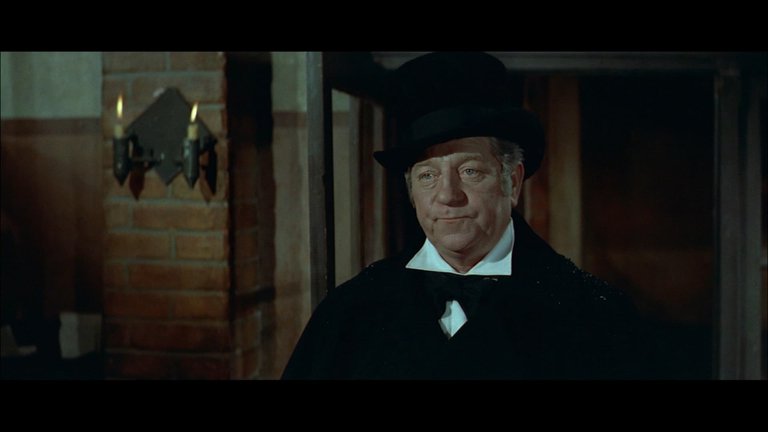Film Review: Les Misérables (1958)

Most individuals today are well-acquainted with Victor Hugo's renowned 1862 novel, primarily due to its successful adaptation into a popular stage musical. However, prior to this, Hugo's work had already garnered significant attention from filmmakers, largely owing to its melodramatic elements. The sheer length of the novel, with some editions exceeding 1,000 pages, posed a considerable challenge for screen adaptations, resulting in a scarcity of faithful renditions. It was not until the advent of miniseries formats on television that more comprehensive adaptations became feasible. Among the big screen adaptations, the 1958 French film directed by Jean-Paul Le Chanois stands out as arguably the most faithful and epic portrayal of Les Misérables.
The film opens in 1802 near the infamous Toulon prison, where we meet the protagonist, Jean Valjean, portrayed by Jean Gabin. Valjean is sentenced to five years of hard labour for the theft of a loaf of bread. His attempts to escape lead to an extended sentence of nineteen years. Upon gaining parole, Valjean finds himself ostracised due to his status as an ex-convict, unable to secure work, food, or shelter. The only exception is Bishop Myriel, played by Fernand Ledoux, who not only offers Valjean refuge but also vouches for him after he is arrested for stealing silver candlesticks. This act of kindness profoundly impacts Valjean, prompting him to reform his life. He moves to Montreuil-sur-Mer, adopts the alias "Monsieur Madeleine," and establishes a successful business while engaging in charitable endeavours, ultimately becoming the town's mayor. One of his charitable acts involves assisting Fantine (played by Danièle Delorme), a young woman forced into prostitution to support her daughter, Cosette (played by Martine Havet), who is being exploited by the unscrupulous innkeeper, Thenardier (played by Bourvil). Valjean's efforts to reunite Fantine with Cosette are thwarted by her untimely death and the revelation of his past by Inspector Javert, played by Bertrand Blier. In a desperate act, Valjean purchases Cosette from the Thenardiers and takes her to Paris, where he works as a gardener under the alias "Fauchelevent." As time passes, Cosette matures into a beautiful young woman (played by Béatrice Altariba), capturing the heart of Marius Pontmercy (played by Giani Esposito), a student involved with the radical revolutionary group, Friends of ABC. The June 1832 uprising against the Orleanist monarchy draws Valjean, Javert, and Marius into its chaotic fray.
For those seeking a condensed introduction to Hugo's novel, the 1958 film serves as an excellent starting point. The screenplay, crafted by Michel Audiard and René Barjavel, remains remarkably faithful to the source material, encompassing characters and subplots often omitted in other adaptations. Notably, the film even includes a brief flashback to the Battle of Waterloo, contributing to its extensive runtime of over three and a half hours.
Produced during a period when French cinema sought to rival Hollywood's grand epics, Les Misérables was filmed in vibrant colour and the Technirama widescreen format. The meticulous recreation of 19th-century France is visually impressive, although some critics have noted that the streets of Paris and the faces of the impoverished appear overly polished for a film addressing themes of human suffering and social injustice.
Hugo's leftist perspective and advocacy for revolution against the privileged classes are more pronounced in this adaptation than in others. The novel's political undertones received considerable acclaim in Communist countries, including East Germany, which contributed to the film's production through the renowned DEFA studios in East Berlin.
While Les Misérables is an impressive adaptation of a literary classic, it falls short as a cinematic achievement, largely due to the uninspired direction of Jean-Paul Le Chanois. His "old school" filmmaking techniques, with the exception of the dramatic barricade scenes, lend the film a coldness that resembles a routine television adaptation rather than a grand epic.
Fortunately, the film is elevated by the exceptional casting of Jean Gabin. At the age of 60, Gabin's charismatic presence significantly enhances the film, allowing audiences to empathise with Valjean's burdensome life. Gabin's portrayal is widely regarded as one of the finest incarnations of Jean Valjean, marking a high point in the career of this iconic French star.
Gabin's performance is complemented by Bernard Blier, who adopts a nuanced approach to the character of Javert. Rather than depicting him as a near-demonic pursuer, Blier presents Javert as a petty bureaucrat who ultimately realises he is chasing a man greater than himself in multiple respects.
However, the remainder of the cast does not leave as strong an impression, with the notable exception of Bourvil, who infuses his comedic talent into the somewhat light-hearted role of Thenardier. The film's soundtrack, composed by Georges Van Parys, similarly lacks the memorability one might expect from a film of such stature.
The 1958 adaptation of Les Misérables stands as a significant cinematic endeavour, successfully capturing the essence of Hugo's monumental work. While it may not achieve the heights of cinematic artistry, its fidelity to the source material and strong performances, particularly by Gabin and Blier, ensure its place in the pantheon of literary adaptations.
RATING: 6/10 (++)
Blog in Croatian https://draxblog.com
Blog in English https://draxreview.wordpress.com/
InLeo blog https://inleo.io/@drax.leo
Hiveonboard: https://hiveonboard.com?ref=drax
Rising Star game: https://www.risingstargame.com?referrer=drax
1Inch: https://1inch.exchange/#/r/0x83823d8CCB74F828148258BB4457642124b1328e
BTC donations: 1EWxiMiP6iiG9rger3NuUSd6HByaxQWafG
ETH donations: 0xB305F144323b99e6f8b1d66f5D7DE78B498C32A7
BCH donations: qpvxw0jax79lhmvlgcldkzpqanf03r9cjv8y6gtmk9
Posted Using InLeo Alpha